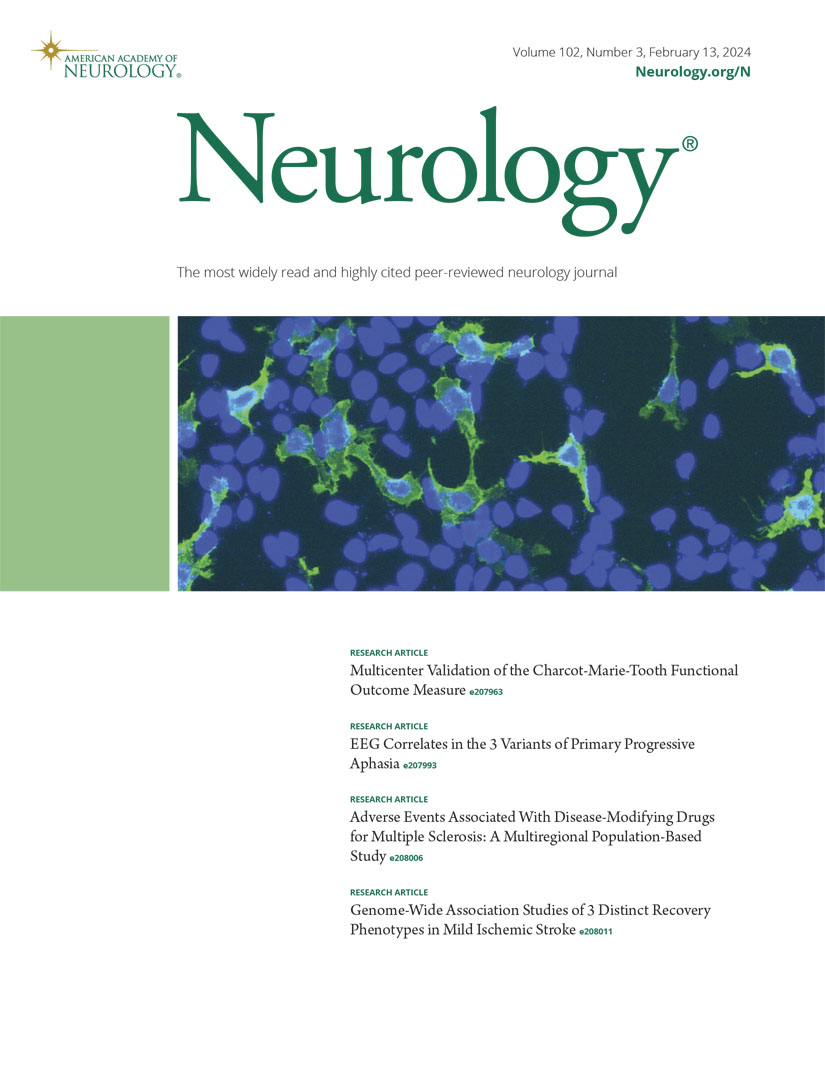Pearls & Oy-sters: Autoimmune Glial Fibrillary Acidic Protein Astrocytopathy Presenting as Encephalomyelitis With Leptomeningeal Enhancement.
IF 7.7
1区 医学
Q1 CLINICAL NEUROLOGY
引用次数: 0
Abstract
Autoimmune glial fibrillary acidic protein (GFAP) astrocytopathy is an uncommon diagnosis in the differential for leptomeningeal enhancement. This case highlights the presentation, imaging features, and investigations important for diagnosis of GFAP astrocytopathy to ensure timely treatment of this corticosteroid-responsive disease. A 50-year-old man from Hong Kong presented with 10 days of progressive urinary retention, dysarthria, diplopia, and gait ataxia after a viral illness. Initial nonenhanced MRI brain was negative. After he developed encephalopathy, repeat MRI with gadolinium on admission day 6 revealed diffuse basal and spinal cord leptomeningeal enhancement. This imaging pattern, in combination with CSF eosinophilia and epidemiologic risk factors, precipitated empiric treatment for tuberculosis meningitis (including dexamethasone). Extensive investigations for an alternate infectious, autoimmune, or malignant diagnosis were negative. Dexamethasone cessation after a gastrointestinal bleed led to clinical and radiologic deterioration. This prompted further CSF and serum testing, which showed positive CSF GFAP-IgG immunofluorescence assay (IFA) (1:128) solidifying the diagnosis of autoimmune GFAP astrocytopathy. Induction with high-dose corticosteroids, intravenous immunoglobulins, and rituximab produced clinical and radiologic remission. Autoimmune GFAP astrocytopathy is an autoimmune disorder with a characteristic perivascular radial enhancement imaging pattern. However, a variety of other clinical and radiologic presentations may be seen, including leptomeningeal enhancement and T2/FLAIR hyperintensities. Diagnosis is confirmed with CSF GFAP-IgG testing. We provide a differential diagnosis for leptomeningeal enhancement and highlight clinical pearls for the diagnosis and management of autoimmune GFAP astrocytopathy.自身免疫胶质纤维酸性蛋白星形细胞病表现为脑脊髓炎伴轻脑膜增强。
自身免疫胶质纤维酸性蛋白(GFAP)星形细胞病是一种罕见的诊断,在鉴别薄脑膜增强。本病例强调了GFAP星形细胞病的表现、影像学特征和检查对诊断的重要性,以确保及时治疗这种皮质类固醇反应性疾病。一名来自香港的50岁男性在病毒性疾病后出现10天进行性尿潴留、构音障碍、复视和步态共济失调。最初的非增强MRI为阴性。在他出现脑病后,入院第6天复查MRI钆扫描显示弥漫性基底和脊髓轻脑膜增强。这种成像模式,结合脑脊液嗜酸性粒细胞增多和流行病学危险因素,促成了结核性脑膜炎的经验性治疗(包括地塞米松)。对其他感染、自身免疫或恶性诊断的广泛调查均为阴性。胃肠道出血后停止地塞米松导致临床和放射学恶化。这促使进一步的CSF和血清检测,结果显示CSF GFAP- igg免疫荧光测定(IFA)(1:128)阳性,巩固了自身免疫性GFAP星形细胞病的诊断。大剂量皮质类固醇、静脉注射免疫球蛋白和利妥昔单抗诱导产生临床和放射学缓解。自身免疫性GFAP星形细胞病是一种自身免疫性疾病,具有特征性的血管周围放射增强成像模式。然而,各种其他临床和放射学表现可能被看到,包括脑膜增强和T2/FLAIR高信号。通过CSF GFAP-IgG检测确诊。我们提供了一个鉴别诊断的脑膜增强和强调临床珍珠自身免疫性GFAP星形细胞病的诊断和管理。
本文章由计算机程序翻译,如有差异,请以英文原文为准。
求助全文
约1分钟内获得全文
求助全文
来源期刊

Neurology
医学-临床神经学
CiteScore
12.20
自引率
4.00%
发文量
1973
审稿时长
2-3 weeks
期刊介绍:
Neurology, the official journal of the American Academy of Neurology, aspires to be the premier peer-reviewed journal for clinical neurology research. Its mission is to publish exceptional peer-reviewed original research articles, editorials, and reviews to improve patient care, education, clinical research, and professionalism in neurology.
As the leading clinical neurology journal worldwide, Neurology targets physicians specializing in nervous system diseases and conditions. It aims to advance the field by presenting new basic and clinical research that influences neurological practice. The journal is a leading source of cutting-edge, peer-reviewed information for the neurology community worldwide. Editorial content includes Research, Clinical/Scientific Notes, Views, Historical Neurology, NeuroImages, Humanities, Letters, and position papers from the American Academy of Neurology. The online version is considered the definitive version, encompassing all available content.
Neurology is indexed in prestigious databases such as MEDLINE/PubMed, Embase, Scopus, Biological Abstracts®, PsycINFO®, Current Contents®, Web of Science®, CrossRef, and Google Scholar.
 求助内容:
求助内容: 应助结果提醒方式:
应助结果提醒方式:


